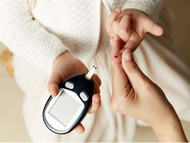Keeping your blood sugar levels in check is extremely important, so you can reduce the risk of heart disease and diabetes.
We spoke with dietitian Melissa Meier about the importance of balancing blood sugar levels and what you need to know about this important energy production process.

Blood glucose, or blood sugar, comes from the food you eat. “Your body can either use it immediately for energy or store it in your muscles or liver to be used another time. Insulin is the key that allows glucose to exit the bloodstream – so, if insulin isn’t very effective, or there simply isn’t enough of it, your blood sugar levels rise more than they should,” Melissa says.
Symptoms of low blood sugar levels include feeling shaky, weak or light headed. In extreme cases, this can lead to a loss of consciousness.
“If your blood sugars are consistently too high, on the other hand, symptoms such as excessive thirst, blurry vision or the need to frequently visit the bathroom may arise.
“If left untreated, having elevated blood sugars over a long period of time can cause permanent damage to your eyes, nerves and kidneys – so it’s a very serious issue,” says Melissa.
Food is vital in stabilising blood sugar levels, with carbohydrates having the biggest effect on your blood sugars. “These are found in grainy foods (like bread, pasta or rice), starchy vegetables (such as potato or corn), fruit and dairy, as well as ‘treat’ foods like pastries, lollies and sugary drinks. For stable blood sugars, you want to include slow-burning carbohydrates, like wholegrain bread, instead of highly refined foods like confectionary that are quickly digested and lead to a rapid spike and crash in blood sugars,” says Melissa.
“A blood sugar rollercoaster will leave you feeling lethargic and tired (and probably reaching for the biscuit jar come 3pm). Instead, you want your blood sugars to gently rise and fall – that way, you’ll be able to maintain your energy levels throughout the day,” Melissa says.
Carbohydrates have become the enemy over recent years with low carb diets becoming the norm. “There’s a big misconception that all carbohydrates are ‘bad’ and cause weight gain, so, inevitably, people think they need to eliminate every trace of them.
“But in my opinion, it’s the quality of the carbohydrates that’s of utmost importance. Including sensible portions of slow-burning carbohydrates is actually crucial to fueling your body properly and receiving adequate nutrition.”
Consistent high blood sugar levels may also be an indicator for diabetes. Diabetes occurs when the body cannot sustain healthy levels of glucose in the blood, inhibiting the ability to produce insulin which is converted into energy. There are three types of diabetes; Type 1 diabetes is where people cannot produce insulin, the condition cannot be prevented and there is no cure.
It can be managed with insulin injections several times a day and people must test their blood sugar levels throughout the day. Type 2 diabetes is where people have to manage their condition through lifestyle changes as the body becomes resistant to the effects of insulin. Gestational diabetes occurs during pregnancy and is diagnosed when higher than normal blood glucose levels first appear.
According to the National Health Survey, there are an estimated 1.2 million people aged 2 years and over with diagnosed diabetes in Australia. It is more important than ever to take care of yourself, so head into your local Blooms The Chemist for a Blood Glucose Screening test. This can assist those recently diagnosed with diabetes, or those with higher risk of developing type 2 diabetes. The test will not confirm if you have diabetes; a high blood glucose reading only indicates there may be an issue. We recommend you speak with your GP for more specific testing.
[1] What should my blood glucose level be? https://www.medicalnewstoday.com/articles/249413.php
[2] Diabetes Australia. https://www.diabetesaustralia.com.au/type-1-diabetes
[3] Diabetes Australia. https://www.diabetesaustralia.com.au/gestational-diabetes
[4] Australian Institute of Health and Welfare. https://www.aihw.gov.au/reports/diabetes/diabetes-compendium/contents/how-many-australians-have-diabetes

